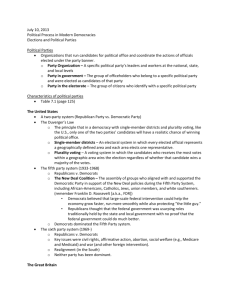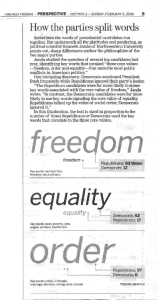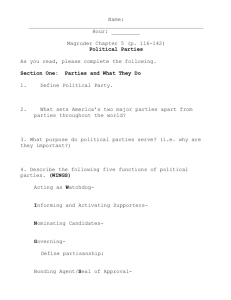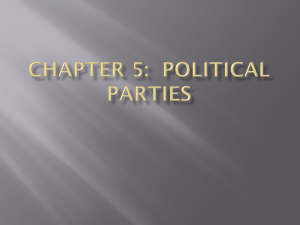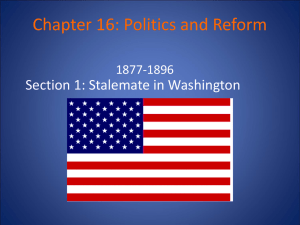File
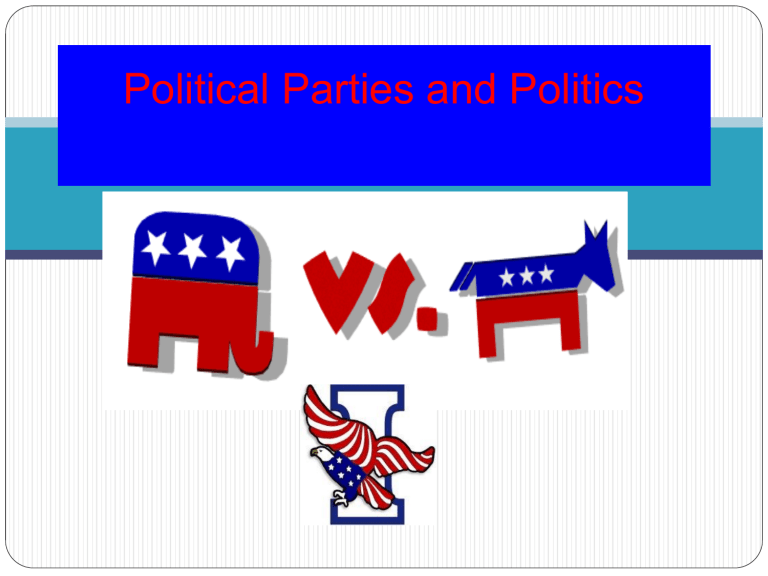
Political Parties and Politics
I.
Party System
Political Party – A group of political activists who have common interest and chose candidates who will represent these interests. Parties are organized to win elections, to operate the government, and to determine public policy.
What are several political parties other than Democrats and Republicans?
Tea Party
II. Functions of Political Parties
A. Selection and Support Candidates
1. Try to choose candidates who have the ability and experience to lead well and who can gain enough public support to get elected.
2. Nominate – name candidates to run for public office
B. Inform the public – tell the public about the party, candidates, and issues
1. Send out mailings
2. Give information to media
3. Arrange meetings with candidates
4. Encourage people to vote
C. Act as Watchdogs – Keep “watch” on the party in power to make sure they are living up to their promises and are telling the public what is important
1. Keep tabs on the other parties members to report any wrongdoing
2. Make sure legislation passed by other party is effective
Town Hall Meeting
D. Give citizens a voice
– provide a way for citizens to be heard
(Example: Town meeting for citizens to express concerns)
E. Get citizens involved – provide a venue for citizens to get involved
1. Pass out campaign information
2. Help raise money
– picnics, dinners
3. Make phone calls to prospective voters
F. Provide leadership – provide leadership necessary to make laws and carry out programs citizens want.
Example: Democrats working on health care legislation
III. Types of Party Systems
A. One Party System- a system in which one political party controls the government and clearly dominates political activities.
1. Advantage – no confusion over which party is in control
- efficient
2. Disadvantage – no other viewpoints are allowed and it is easy for there to be an abuse of power
3. Example: China
Communist Party in China
How strong is China's economy?
Cuba (Communist Party of Cuba) 1959
B
. Two Party System
– a system in which there are two political parties dominate the political system and compete for political power.
1. Advantage a. Stabilizing b. provides continuity
2. Disadvantage - can stifle views of minority groups or parties
3. Example –
1. U.S.A
. : federal constitutional republic, in which the
President of the U.S. (the head of state and head of government), Congress, and judiciary branch share powers reserved to the national government, and the federal government shares sovereignty with the state governments.
.
Example
2. Australia: parliamentary democracy, has electoral procedures appropriate to a two party system.
Australia is governed as a constitutional monarchy
C. Multiparty System - a system in which there are several political parties trying to control the political system and thus the government.
1. Terms a. Coalition – an alliance with another party or parties so that together they command a majority of votes b. Plurality – winning more votes or seats in a legislature than any other party, not necessarily a majority c. Majority – winning more than half the votes cast or seats available
2. Advantage – provides a broad range of choices
3. Disadvantage a. Difficult for one party to get enough votes to form a government b. Coalitions must be formed and they are often unstable
4. Examples:
1. Germany
2. Italy
3. Japan
4. Israel
Multi Party example
12
15
33
Coalition = majority
Plurality = winner but not a majority
Majority = more than half
Students Draw Examples NOW!
;-)
11
23
The World From Berlin
Hamburg Collapse Shows CDU-
Green Alliances are a 'Pipe
Dream'
Merkel's Coalition Partner in
Trouble
Infighting Flares in Foreign
Minister Westerwelle's FDP
The collapse of the Hamburg city government on Sunday spells the failure of a test run for possible coalitions between Chancellor Angela
Merkel's conservatives and the
Greens, say German media commentators. Merkel's nuclear policy has returned the battle lines of German politics to the old left-right confrontation.
When the Greens entered into an unprecedented coalition with
Chancellor Angela Merkel's conservative Christian Democratic
Union party (CDU) in the citystate of Hamburg in early 2008, the alliance was hailed as a possible model for a future national government one day.
The troubles of the Free
Democrats, junior partners in
Chancellor Angela Merkel's governing coalition , have been compounded by incendiary comments from a leading party member. Wolfgang Kubicki told
SPIEGEL that the party was at risk of "imploding" like East
Germany's communist regime.
The pro-business Free Democratic
Party (FDP), the junior partner in
Chancellor Angela Merkel's centerright coalition, is embroiled in a leadership row triggered by its dramatic slump in opinion polls this year.
These are just news examples of coalitions.
Germany
List of Italy’s Multiparties
Christian
Democratic Party (Partito della Democrazia Cristiana; DC)
Italian Communist Party (Partito Comunista Italiano; PCI),
Italian Social Movement (Movimento Sociale Italiano; MSI)
Italian Socialist Party (Partito Socialista Italiano; PSI)
Italian Popular Party (Partito Popolare Italiano; PPI),
Forza Italia (FI; loosely translatable as “Go Italy”),
Northern League (Lega Nord; LN
National Alliance (Alleanza Nazionale; AN),
Democratic Party of the Left (Partito Democratico della Sinistra; PDS), later shortened to the Democrats of the
Left (Democratici di Sinistra; DS).
Democratic Party (Partito Democratico), emerged when the DS merged with the centrist Daisy (Margherita) party
People of Freedom (Popolo della Libertà; PdL) party .
Japanese
politics uses a multi-party system.
The politics of Japan is conducted in a framework of a parliamentary, representative democratic monarchy, where Prime Minister of Japan is the head of government.
IV. History of Political Parties in the U.S.
A. Development of Two Party System
1.
The first political parties formed in the debate over the Constitution a. Federalist – supported the Constitution b. Anti-Federalist- Opposed the Constitution and became known as the
Democratic- Republicans
2. Since the division over the Constitution, political control of the U.S. has been held by two main parties
3. The party’s in control have changed.
a. Democratic- Republicans became the Democrats – in support of slavery
(opposed Andrew Jackson 1828) b. National Republicans/Whigs : split from the D-R to promote strong national government, compete with democrats c. Democratic : (present) (supported Andrew Jackson in 1828) , two main political parties in the U.S.
d. Republican: anti –slavery formed to oppose the Democrats (Lincoln) e. Since the 1860 the Democrats and Republicans have been the two main political parties in the U.S.
Modern US Political Party History
V. Third Parties – a minor party that is challenging the main party’s
A. Why Third Parties Form
1. To support a Single Issue- Prohibit Party- opposed alcohol and wanted to see it banned
2. To support Political Beliefs a. American Socialist Labor Party – opposed alcohol and wanted to see it banned b. Libertarian Party – Support individual liberty and personal responsibility, a free market economy, and a foreign policy of non-intervention and free trade c. Green Party
– committed to environmentalism, non-violence, social justice and grassroots organizing with out the support of corporate donors d. American Reform Party- want to reduce government size, have a balanced budget and a national sales tax or a graduated flat tax, and reduce the influence of special interests in government
3. Support a Single Candidate a. George Wallace
– American Independent, 1964 b. John Anderson
– Independent Party, 1978
c. Ross Perot, The Reform Party1992 and 1996 d. Ron Paul - Libertarian, 2008
B. Problems Facing Third Party
1. Hard to get on the ballot
2. Difficult to raise money
3. Often supporters vote for someone else because they do not want to waste their vote voting for someone they believe will not win.
Qualifications for being on NC’s ballot
Major party qualifications:
Received 10% of state votes cast in the previous presidential election
Or petition 2% of votes cast in most recent gubernatorial election [G.S. 163-96]
Primary ballot access:
1. State Board of Elections
Nominates candidates who have become eligible for matching funds [G.S. 163-213.4]
2. Petition (for those not selected)
10,000 signatures of registered voters of the same party as the candidate [163-213.5]
Recognized parties as of January 2003: Democratic , Republican, and Libertarian
General ballot access for new party candidates:
During the first election after qualification as a political party, the new party nominates by convention rather than primary [G.S. 163-98]
Deadline: July 1 [163-98]
VI. Political Labels
A. Liberal – call for peaceful and gradual change of the nations political system, would like to see the government involved in the promotion of the social welfare of the nation’s citizens.
B. Conservative – favor keeping things the way they are, they are cautious about making change especially if it involves a lot of government involvement, they feel that less government is best
C. Centrist or Moderate – share many view points with both liberals and conservatives, they do not hold extreme views of their own and advocate a slower approach to political change
D. Reactionary – on the far right of the political spectrum, want things to go back the way they were, are willing to use extreme methods to achieve their goals including repressive government power
E. Radical – on the far left of the political spectrum, call for widespread and rapid change in the political change in the political, social, and economic system, may be willing to resort to extreme methods to bring about change including violence
This is an imaginary line. However, it represents the range of political philosophies and beliefs. Most individuals can place themselves somewhere along the spectrum once they understand the two extremes.
(Liberal)
LEFT
Radical
•Want quick change in government and will resort to extreme methods
Liberal
(Left Wing)
•Peaceful gradual change, like to promote social welfare
•Gov’t should protect & extend the right of citizens
Centrist or Moderate
(Middle of the Road)
•Share views with both sides.
•This is where most
Americans fall
Reactionary
•Want things to go back to
“the way they were” are willing to use extreme methods
Conservative
(Right Wing)
•Keep things the way they are, cautious about change, favor less government
•Gov’t should play a limited role in the lives of individuals
(Conservative)
RIGHT
Do you think Americans Ideology has changed since 2009?
VII. Impact of political labels on elections
A. A majority of americans’ political viewpoints fall in the moderate range – neither very conservative nor very liberal
B. Candidates also try to make themselves seem moderate to attract as many voters as possible.
C. A majority of a party’s positions (planks are very moderate to appeal to the most people)
Planks: Individual issues that a candidate believes
: prolife v prochoice, pro-health care, reform verses rugged individualism,
Platform A formal declaration of the principles on which a group, such as a political party, makes its appeal to the public.
Economic Development
Health Care
Welfare
Social Security
Tax Cuts
Supports big business
Supports small business
Strong Military
Unemployment
Support Education
Environment
Free Enterprise System
Fight Crime
Help the Elderly
VIII. Political Party Organization
A. Local Level
– organize volunteers to get people to vote and work to elect people to local government offices like the sheriff, county commissioners, mayors
Precinct – an election distinct of a city or town
B. State level
– organize campaigns to get candidates elected to national office
1. Political Machine
– an unofficial system that controls the activities of a party or candidate. It is based on patronage, the act of supporting or favoring some person or group. The patron or boss does favors for the constituents and the constituents vote as the boss request or requires. This system was most prevalent in the U.S. 1875-1920.
a. Real life Example: Boss Tweed’s notorious Tammany Hall in NY city b. Movie Example: Mr. Smith goes to Washington – James Taylor
New York's New
Tammany HallThe new
Tammany Hall on East 17th
Street, home of New York's
Democratic Party, upon its completion in 1929.
Notorious politician William
Marcy "Boss" Tweed led
Tammany Hall in the 1860s, and with the help of his fellow politicians stole between
$30,000,000 and
$200,000,000 from the city of New York.
IMAGE:
© Bettmann/CORBIS
DATE PHOTOGRAPHED
1929
LOCATION
Manhattan, New York, New
York, USA
COLLECTION
Bettmann
The spoils system is the practice of appointing people to public office on the basis of a personal relationship, or affiliation, rather than because of their merits. The spoils system has existed since the presidency of Andrew Jackson, but it is not seen exceedingly often today.
Merit System : uniform and impersonal method for advancement within a job setting based work performance and evaluation.
The Pendleton Civil Service Reform Act made the merit system common practices
C. Organize National Convention a. Held once every four years b. Each party holds their own convention in separate locations c. Delegates from each state vote for candidate that is their state’s choice to be the party’s presidential candidate
Johnson v. Texas
1 . Help write party platforms a. Platform – series of statements that explain a party of candidate’s views, beliefs, and positions.
b. Platform are made of planks – a statement about a party’s position on an individual political issue.
c. The party’s official position on the issues is finalized at the convention.
When a party gets all of their planks together they build a platform to stand on.
Economic Development
Health Care
Welfare
Social Security
Tax Cuts
Supports big business
Supports small business
Strong Military
Unemployment
Support Education
Environment
Free Enterprise System
Fight Crime
Help the Elderly
IX. Comparison of Two Main Parties
Views on Current Issues
A. similarities
1. Both parties avoid taking extreme stands on issues
2. Both parties try to appear moderate to attract the largest number of voters
Standing Strong by Holland Berkley
differences
Government Involvement
Democrats
– tend to favor stronger government control and having more decision making capabilities with less central government involvement and regulation
Republicans – tend to favor state governments having more decision making capabilities with less central government involvement and regulation
Taxes
Democrats – favor tax cuts for small businesses and self-employed
Republicans – favors an across the board tax cut
. Health Care
Democrats
– supports the government providing options for all individuals
Republicans – support people taking responsibility for themselves and allowing businesses and individuals to handle these issue
Education
Democrats –support public schools being funded to provide quality education for all citizens regardless of socio-economic status.
Republicans
– promote school choice on all levels, supports an increase in student loan programs, support the voucher system and no child left behind, accountability for teachers
Democrats:
Republicans:
Homosexuality
Democrats : more tolerant and accepting
Republican : less tolerant and do not agree with legal recognition of same sex marriage
Can you think of another topic for a plank?
_______________________
